Avancerad teknik för mätning av infraröd temperatur
Temperatur mäts vanligtvis i tillverkning för att övervaka och kontrollera produktkvalitet och processproduktivitet. Många tillämpningar använder kontaktanordningar som termoelement och RTD:er, men alltför ofta är dessa anordningar opålitliga, för långsamma, svåra att använda eller kräver frekvent utbyte, vilket leder till produktionsstopp och minskad produktivitet. För många tillämpningar är infraröda pyrometer den perfekta lösningen eftersom de kan mäta en måltemperatur korrekt och pålitligt utan kontakt.
Single-Wavelength Pyrometers
Single-Wavelength Pyrometers
There are three distinct Single-Wavelength pyrometer technologies: Short-Wavelength, Long-Wavelength, and Specialty-Wavelength. Single-Wavelength pyrometers are preferred when appropriate due to simpler, lower-cost technology. For most applications, select the shortest wavelength compatible with the measurement conditions and desired temperature span. Specialty wavelengths may be necessary depending on the optical and emissivity properties of the target.
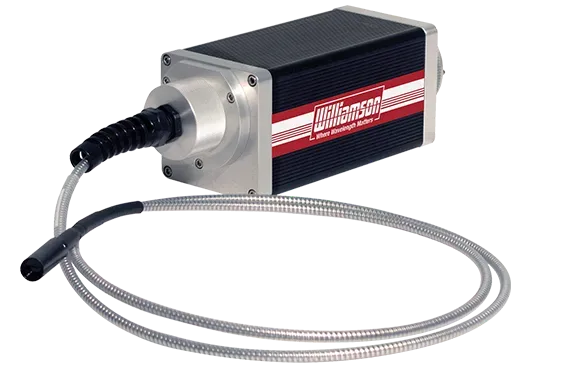
Short-Wavelength Pyrometers
Williamson places a strong emphasis on short-wavelength single-wavelength pyrometers because of their ability to better tolerate emissivity variation and optical obstruction.
- Short-wavelength sensors are often 4-20 times less sensitive to emissivity variation compared to long-wavelength sensors
- By selecting the correct wavelength span, Williamson pyrometers make it possible to view through water, steam, flames, combustion gases, and plasmas.
As a result, Williamson short-wavelength pyrometers provide superior performance over a wide range of real-world operating conditions.
Long-Wavelength Pyrometers
Long-Wavelength (LW) pyrometers tend to be lower in cost, but when measuring temperatures above 100˚C / 200˚F, errors can be large due to optical obstructions, misalignment, and emissivity variations. These are general purpose sensors are used for many low-temperature or near ambient measurements and high emissivity materials.
Specialty-Wavelength Pyrometers
Specialty-wavelength pyrometers are used when the target is least reflective and most opaque at a specific wavelength or when optical obstructions are most transparent at a specific wavelength. For example, at 7.9um polyester film is opaque. So pyrometers filtered at this special wavelength are appropriate for making this measurement.
Multi-Wavelength Pyrometers
Multi-Wavelength Pyrometers
Williamson is the only company that offers two types of multi-wavelength pyrometers. The MW and MWx pyrometers are used to measure the temperature of non-greybody materials. These are materials for which the emissivity not only varies, but varies differently at different wavelengths.
Williamson’s multi-wavelength pyrometers use application specific algorithms to characterize infrared energy and emissivity to accurately calculate the temperature of these complex non-greybody materials. Algorithms have been developed and refined from extensive data collected from off-line simulations and on-line trials. These pyrometers also have a real-time measure of emissivity, confirming valid temperature measurement conditions and alerting you of invalid conditions that require troubleshooting.
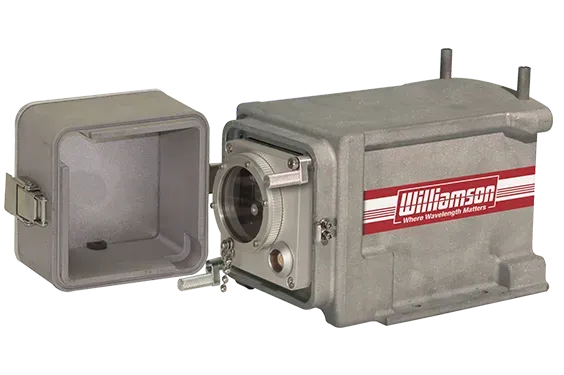
Traditional MW Pyrometers
MW Pyrometers provide consistent and accurate measurements with non-greybody materials under a wide range of operating conditions without any adjustments. The MW pyrometers use application specific ESP Algorithms to accurately correct for emissivity variations due to:
- Changes in alloy, surface texture, surface oxidation
- Abnormal operating conditions such as a furnace leak, bad roll, or reheated coil (Annealing Line)
The most common applications involve aluminum, steel, and copper. Each MW pyrometer can hold up to eight selectable algorithms so that the same sensor can be used for multiple applications.
Dynamic MWx Pyrometers
The MWx pyrometers work differently than traditional MW technology which assumes that the surface conditions are relatively consistent. The MWx sensors use Dynamic ESP Technology to automatically compensate for more significant variation in surface character and conditions without any adjustments. The two applications which require the more advanced MWx technology are:
- Aluminum hot rolling mills where the surface character of the aluminum varies dramatically by alloy and pass as it goes through the reversing mill.
- High temperature (<900°F/480°C) aluminum billets where there is an elemental migration of aluminum to the outside billet surface that dramatically changes the emissivity of the billet surface.
Infrared Petrochemical Sensors
Williamson products are used throughout the chemical and petrochemical industries. Williamson industrial infrared thermometer technology provides significant advantages over other technologies like thermocouples, UV detectors, and thermal imagers when it comes to monitoring flares and thermal reactors.
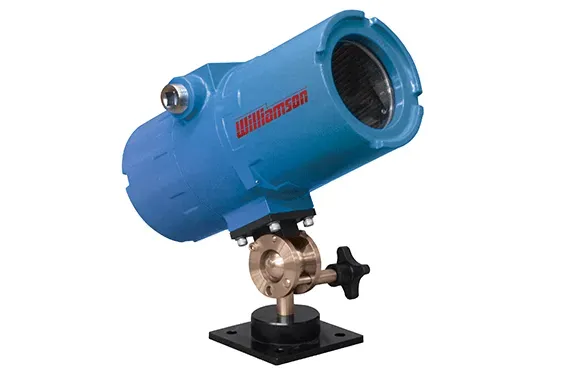
Smokeless Flare Monitor (FM)
- Assures smoke-free operating conditions
- Ensures high combustion efficiency
- Can be used to reduce energy costs related to excessive steam/air assist

Pilot Flame Monitor (PM)
- Confirms the presence of a lit pilot flame – even through fog, rain, snow, and sleet
- Can be used as a backup monitoring device for when thermocouples fail
- Mounted at ground level for easy access

Flame Intensity Monitor (FI)
- Used for ground flares or when viewing distance is < 300ft/100m
- Best for H2, CO, or ammonia flames
- Output can be used to determine the difference between pilot flame and flaring conditions
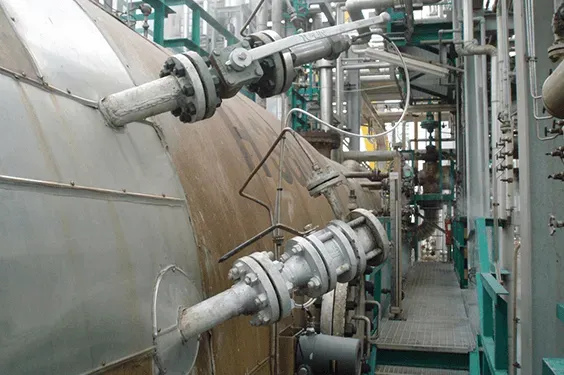
Sulfur Recovery Unit (SRU)
- Fiber optic configuration eliminates the need for active cooling
- Warm flange mounting reduces/eliminates sulfur deposition in the optical path
- Option to measure either gas temperature or wall temperature
Ratio Pyrometer Technology
Ratio Pyrometer
Williamson is the only company that can offer two different ratio technologies: two-color and our unique dual-wavelength. Ratio pyrometers are different from single-wavelength pyrometers because they measure infrared energy at two wavelengths instead of one.
The ratio of energy between the two measured wavelengths is then converted into a temperature value. This method of measurement allows ratio industrial infrared pyrometer technology to compensate for emissivity variation, partially filled fields of view, and optical obstructions.
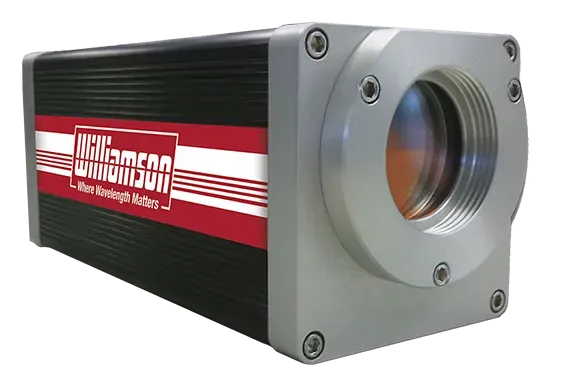
TWO-COLOR
Two-color pyrometers use what is called a “sandwich detector” using a fixed set of wavelengths, meaning that two wavelength filters are laid one on top of the other. One wavelength is a broad waveband (0.7-1.1um for example) and the other wavelength is a narrow waveband (1.0-1.1) that is a subset of the broader band.
- General purpose wavelength set
- Can tolerate modest optical obstructions, misalignment and partial field of view
- Compensate for variable emissivity
- Used when there is a clear optical path between the pyrometer and target
- Can only measure temperatures above 1100°F / 600°C
Keep in mind that two-color pyrometers cannot view through common optical interferences, so it is critical to avoid water, steam, flames, combustion gasses, plasma and laser energy for the most accurate and repeatable results.
DUAL-WAVELENGTH
Dual-wavelength pyrometers use two separate and distinct wavelength sets on a filter wheel. Because the design allows for separate wavelengths, these wavelength sets can be independently selected and combined allowing for some unique capabilities.
- Compensate for variable emissivity, temperature gradients, severe optical obstructions, and misalignment
- Select wavelength sets tolerate water, steam, flames, combustion gasses, plasma, and laser energy
- Separation of wavelengths produces a heavily weighted reading towards the hottest temperature viewed
- Available in broad temperature spans and low-temperature ranges
- Includes ESP filtering to continuously measure intermittent targets or eliminate intermittent interferences
Dual-wavelength pyrometers offer two different and selectable wavelengths allowing for all of the benefits of a two-color pyrometer plus some additional capabilities.
Kontakta oss om du vill veta mer om dessa produkter

